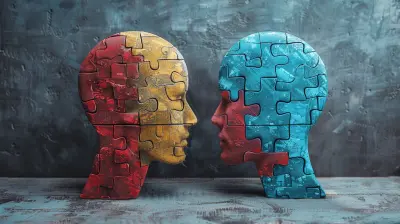Problem-Solving Approaches for Different Learning Styles
11 February 2025
When we think about learning, it's easy to assume that everyone absorbs information in the same way. However, that's far from the truth! People have different learning styles, and these styles significantly affect how they approach problem-solving. Understanding these different approaches can help both learners and educators develop more effective strategies for tackling challenges.
In this article, we’ll dive into various learning styles, explore how each style impacts problem-solving, and offer practical tips to maximize problem-solving potential for each type of learner. Ready to unlock the full potential of your brain? Let’s get into it!

What are Learning Styles?
Before we jump into problem-solving approaches, let's first clarify what we mean by "learning styles."In simple terms, learning styles are the different ways people prefer to take in, process, and retain information. You might have heard of the VARK model, which breaks learning styles down into four categories:
1. Visual Learners – Learn best through seeing.
2. Auditory Learners – Learn best through listening.
3. Reading/Writing Learners – Learn best through reading and writing.
4. Kinesthetic Learners – Learn best through physical activities and hands-on experiences.
While this classification is helpful, remember that most people aren't limited to just one learning style. Many learners are a mix of these categories, but they may have one dominant preference.
Now that we know what learning styles are, let’s explore how different learners approach problem-solving.
Visual Learners: Seeing is Solving
Characteristics of Visual Learners
Visual learners are often those people who love diagrams, charts, and pictures. They tend to think in images and enjoy organizing information in a way that is visually appealing. You might see them doodling or sketching out ideas when they're trying to solve a problem.Problem-Solving Approach for Visual Learners
For visual learners, the best way to tackle a problem is by visualizing the issue. These learners thrive when they can see the problem laid out in front of them.Tips for Problem-Solving:
- Mind Maps: Visual learners can use mind maps to break down complex problems into smaller, more manageable parts. By creating a visual representation of the problem, they can see connections between different elements.- Flowcharts: Flowcharts are another great tool for visual learners. They help outline a sequence of steps, making it easier to see the path toward a solution.
- Color Coding: Adding colors to different parts of the problem can help categorize and prioritize information. This can make it easier for visual learners to focus on key areas.
Imagine you’re trying to solve a puzzle. For a visual learner, the pieces make more sense when they’re laid out clearly in front of them, right? The same goes for problem-solving.
Auditory Learners: Talk it Out
Characteristics of Auditory Learners
Auditory learners process information best when they hear it. These learners often prefer lectures, discussions, and listening to explanations. They may not be big fans of reading long texts but can recall conversations in detail.Problem-Solving Approach for Auditory Learners
For auditory learners, talking through a problem is the key to finding a solution. They often need to hear themselves or others explain a problem before they can begin to work through it.Tips for Problem-Solving:
- Group Discussions: Auditory learners benefit from brainstorming sessions and group discussions. Hearing different perspectives can help them piece together a solution.- Record Your Thoughts: If you're working alone, try recording yourself as you explain the problem out loud. Later, you can play it back and listen for insights you might have missed.
- Verbal Instructions: When approaching a problem, auditory learners may find it useful to repeat instructions or key points out loud to reinforce their understanding.
Think of it this way: If you're an auditory learner, it's like having a conversation with the problem itself. You’re more likely to find the solution when you can talk it out.
Reading/Writing Learners: Pen and Paper Power
Characteristics of Reading/Writing Learners
These learners are most comfortable with text. They prefer to read about a problem, make detailed notes, and write out their thoughts. They're the ones who will likely have a notebook full of information, even if it’s just for a simple task.Problem-Solving Approach for Reading/Writing Learners
For reading/writing learners, the process of writing things down can be the key to unlocking a solution. They often need to read through instructions or articles and jot down notes to fully understand a problem.Tips for Problem-Solving:
- List-Making: Start by making lists of the problem's components, possible solutions, and necessary steps. This will help reading/writing learners organize their thoughts.- Research: These learners are likely to benefit from reading about similar problems and solutions. The more information they can absorb through text, the better equipped they’ll be to solve the issue.
- Note-Taking: Writing down key points or summarizing the problem in their own words can help reinforce understanding and clarify the steps needed to solve the problem.
For reading/writing learners, think of solving problems like writing an essay. You gather all the information, organize it, and work through it one step at a time.
Kinesthetic Learners: Hands-On Problem Solvers
Characteristics of Kinesthetic Learners
Kinesthetic learners are all about action. They prefer hands-on experiences and learn best by doing. These learners often struggle with sitting still for long periods and may fidget or move around while trying to solve a problem.Problem-Solving Approach for Kinesthetic Learners
Kinesthetic learners need to physically engage with the problem. Whether that means building a model, experimenting, or using physical objects, they need to get their hands "dirty" to fully grasp the issue.Tips for Problem-Solving:
- Physical Models: If possible, create a physical model of the problem. For example, if you’re solving a mathematical problem, use objects like blocks or coins to represent different variables.- Role-Playing: For more abstract problems, kinesthetic learners can benefit from role-playing scenarios. Acting out the situation can help them understand the dynamics at play.
- Movement Breaks: Kinesthetic learners tend to think better when they’re in motion. If you're stuck on a problem, take a break to move around, stretch, or engage in a physical activity. The solution might come to you while you’re on the move!
If you’re a kinesthetic learner, think of problem-solving like building something with your hands. You need to touch, feel, and interact with the problem to find the solution.
Combining Learning Styles: The Hybrid Approach
While we’ve broken down problem-solving approaches based on specific learning styles, it’s important to remember that many people are a mix of these styles. You might find that you lean toward visual learning but also benefit from talking through problems or taking notes.In fact, combining these approaches can often lead to the most effective problem-solving strategy. For example, you might start by creating a mind map (visual learning), then explain the problem out loud (auditory learning), write down your observations (reading/writing learning), and finally build a model or prototype (kinesthetic learning).
By mixing and matching different techniques, you can tailor your problem-solving approach to what works best for you.
Adapting Problem-Solving for Education
As educators, understanding that students have different learning styles is crucial. Not every student is going to approach a problem the same way, so it's important to offer diverse problem-solving strategies.Here are some tips for educators:
1. Offer Variety: Provide multiple ways for students to approach problems. This could include visual aids, group discussions, written assignments, and hands-on projects.
2. Encourage Self-Awareness: Teach students to recognize their own learning styles and encourage them to experiment with different problem-solving strategies.
3. Create a Flexible Environment: Allow students the freedom to choose the methods that work best for them. Some might prefer working alone, while others thrive in group settings.
By acknowledging and accommodating different learning styles, educators can help students become more confident and effective problem solvers.
Conclusion
Problem-solving is a critical skill, but the way we solve problems depends largely on how we learn. Visual learners need to see the problem, auditory learners need to hear it, reading/writing learners need to write it down, and kinesthetic learners need to physically engage with it.By understanding these different learning styles and their corresponding problem-solving approaches, you can not only improve your own problem-solving skills but also help others unlock their full potential.
So, what’s your learning style? Now that you know how it affects your problem-solving approach, you’re one step closer to cracking the code of any challenge that comes your way!
all images in this post were generated using AI tools
Category:
Problem SolvingAuthor:

Anita Harmon
Discussion
rate this article
18 comments
Oberon McCollum
Embrace diverse strategies to empower every learner's unique strengths!
April 7, 2025 at 6:29 PM

Anita Harmon
Absolutely! Embracing diverse strategies is key to unlocking the potential of every learner. Each approach can cater to unique strengths and enhance problem-solving skills effectively.
Drake McClintock
What a delightful read! This article brilliantly showcases how diverse problem-solving approaches can cater to various learning styles. It’s inspiring to see how tailored strategies can empower every learner. Let’s celebrate our unique ways of thinking and encourage exploration in learning! Keep shining your light on education! 🌟
March 2, 2025 at 11:59 AM

Anita Harmon
Thank you for your kind words! I'm glad you found the article inspiring. Celebrating diverse approaches is essential for empowering all learners! 🌟
Wynter Reilly
This article effectively highlights the importance of tailored problem-solving strategies, emphasizing that recognizing individual learning styles can significantly enhance student engagement and foster deeper understanding in diverse educational contexts.
February 28, 2025 at 12:04 PM

Anita Harmon
Thank you for your insightful comment! I'm glad you found the article's emphasis on tailored strategies and individual learning styles valuable for enhancing student engagement.
Caden McCarthy
This article effectively highlights the importance of tailoring problem-solving strategies to diverse learning styles. By recognizing individual preferences, educators can enhance student engagement and comprehension. Implementing these approaches not only fosters critical thinking but also cultivates a more inclusive learning environment for all learners.
February 28, 2025 at 5:26 AM

Anita Harmon
Thank you for your insightful comment! I'm glad you found the article valuable in emphasizing the connection between tailored problem-solving strategies and diverse learning styles. Your feedback highlights the importance of inclusivity in education.
Cara Sawyer
This article effectively highlights the importance of tailoring problem-solving strategies to diverse learning styles, yet it could delve deeper into practical applications and real-world examples for enhanced engagement.
February 26, 2025 at 4:00 AM

Anita Harmon
Thank you for your feedback! I appreciate your suggestion to include more practical applications and real-world examples, and I'll consider this for future revisions.
Mitchell Morales
Why did the student bring a ladder to class? To reach new heights in problem-solving! Embracing different learning styles is like having a toolbox; every style has a tool that makes tackling challenges a bit more fun (and a lot less stressful)!
February 25, 2025 at 9:33 PM

Anita Harmon
Thank you for your clever comment! Embracing diverse learning styles truly does elevate the problem-solving experience.
Lys McNulty
In the dance of minds, diverse paths unfold, Each learner's heart, a story untold. With tailored approaches, we unlock the key, To ignite the spark in every unique plea.
February 24, 2025 at 5:13 AM

Anita Harmon
Thank you for your poetic insight! Embracing diverse learning styles truly enriches problem-solving and fosters innovative thinking.
Kara Benton
This article offers valuable insights into tailoring problem-solving techniques to various learning styles. I appreciate the emphasis on adaptability, as it highlights the importance of personalized learning. Incorporating real-life examples could further enhance understanding and application of these approaches in diverse educational settings. Great work!
February 23, 2025 at 12:40 PM

Anita Harmon
Thank you for your thoughtful feedback! I appreciate your suggestion about incorporating real-life examples to enhance understanding. I'm glad you found the insights valuable!
Melissa Shaffer
Great insights! Recognizing diverse learning styles is crucial for effective problem-solving. Tailoring approaches not only enhances understanding but also fosters a more inclusive learning environment. Keep it up!
February 23, 2025 at 4:05 AM

Anita Harmon
Thank you! I'm glad you found the insights valuable. Embracing diverse learning styles truly enriches the problem-solving process.
Kassandra Elliott
This article effectively highlights the importance of tailored problem-solving strategies, fostering deeper engagement for diverse learners' unique needs.
February 22, 2025 at 1:55 PM

Anita Harmon
Thank you! I'm glad you found the article emphasizes the significance of tailored strategies for diverse learners. Your engagement with the topic is appreciated!
Uriel Pope
Great insights! Tailored strategies matter.
February 22, 2025 at 4:09 AM

Anita Harmon
Thank you! I'm glad you found the insights valuable. Tailoring strategies truly enhances learning.
Joy McNair
Great insights! Understanding diverse problem-solving approaches can truly empower educators to connect with all students. Tailoring strategies to learning styles makes a world of difference!
February 20, 2025 at 7:55 PM

Anita Harmon
Thank you! I’m glad you found it valuable. Tailoring approaches really does enhance engagement and learning outcomes for all students.
Angie Good
This article wonderfully highlights the diverse ways individuals approach problem-solving based on their unique learning styles. I'm intrigued by how integrating various methods can enhance collaboration in educational settings. I look forward to exploring practical strategies that cater to all learners’ needs! Great insights!
February 18, 2025 at 1:07 PM

Anita Harmon
Thank you for your thoughtful comment! I'm glad you found the insights valuable and I'm excited for you to explore practical strategies for enhancing collaboration among diverse learners. Your enthusiasm for this topic is inspiring!
Elin McTigue
This article offers valuable insights into tailoring problem-solving techniques to diverse learning styles, highlighting the importance of adaptability in education to foster deeper understanding and engagement.
February 16, 2025 at 7:53 PM

Anita Harmon
Thank you for your feedback! I'm glad you found the insights on adaptability in education valuable for enhancing problem-solving techniques.
Maura Jordan
One size never fits!
February 16, 2025 at 4:06 AM

Anita Harmon
Absolutely! Tailoring solutions to individual learning styles enhances engagement and effectiveness.
Logan Sawyer
“Why solve problems like a squirrel in a dance-off? Embrace your learning style and shimmy to success!”
February 13, 2025 at 11:18 AM

Anita Harmon
Great analogy! Embracing unique learning styles can definitely lead to creative and effective problem-solving!
Finnegan James
Unlocking the potential of diverse learning styles is key to fostering effective problem-solving! Embrace creativity, adaptability, and open-mindedness to tailor approaches that resonate with every learner. Together, let’s cultivate an inclusive educational environment where every student thrives, empowered to tackle challenges with confidence!
February 12, 2025 at 9:29 PM

Anita Harmon
Absolutely! Embracing diverse learning styles enhances problem-solving and fosters an inclusive environment where all students can thrive and build confidence in tackling challenges.
Veda Torres
What a delightful read! Understanding problem-solving through various learning styles opens up a world of possibilities for students. Embracing these unique approaches can truly enhance engagement and creativity. Here's to inspiring all learners on their educational journeys! 🌟📚
February 11, 2025 at 3:22 AM

Anita Harmon
Thank you! I'm glad you enjoyed the article. Embracing diverse learning styles is key to fostering creativity and engagement in problem-solving. Here's to inspiring all learners! 🌟📚
MORE POSTS

How Effective Leadership Can Transform School Communities

How Emotional Intelligence Contributes to Problem-Solving Success

The Science Behind Self-Assessment: How It Improves Learning Retention

The Role of Play in Early Childhood Teacher Training

The Importance of Collaborative Teamwork in Special Education

Problem-Solving Frameworks Every Student Should Learn

How Open Educational Resources Are Shaping the Future of Learning

Teaching Students About the Power of Words: Combating Verbal Bullying

How to Create a Self-Assessment Routine for Ongoing Academic Improvement

Using Literature Circles to Deepen Understanding in the Classroom

How to Write a Persuasive Argument with Evidence